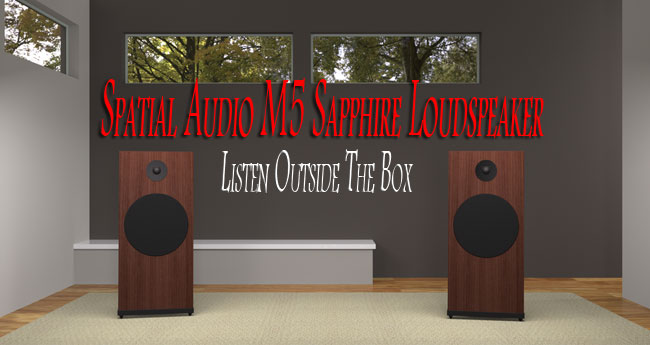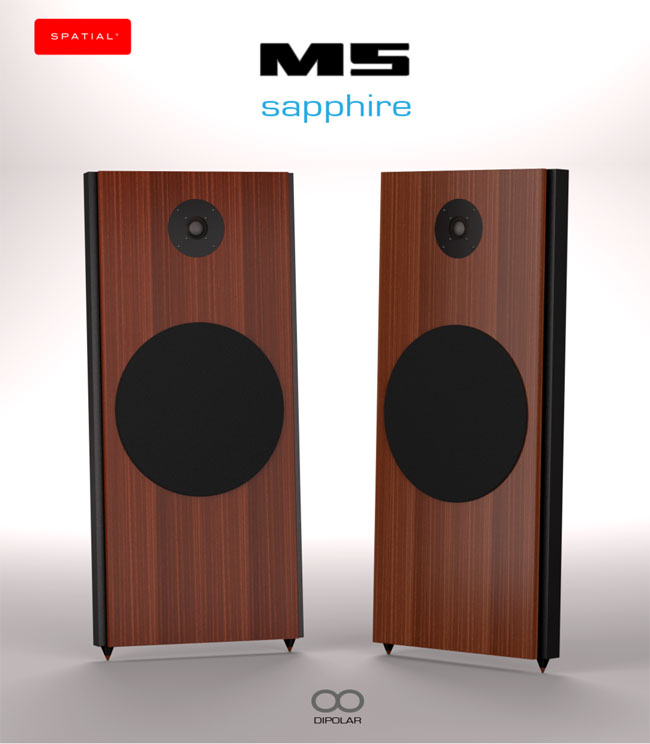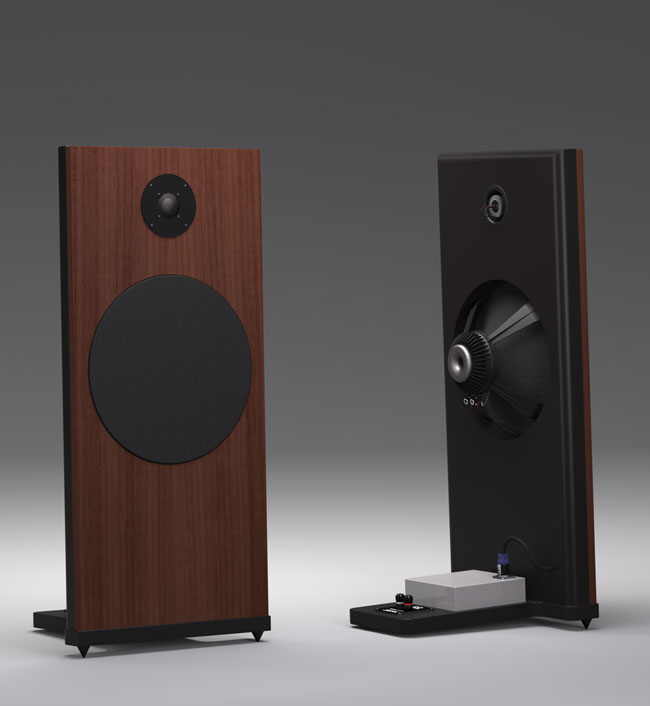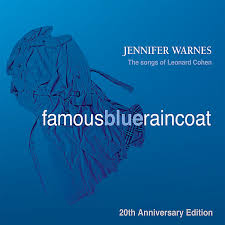Spatial Audio M5 Sapphire Loudspeaker by Don Shaulis

 Sometimes life gives us a punch in the gut or kicks in the butt as a message to move on. This summer, one of my beloved Quad ESL-2805s in the rare and more attractive Classic finish began to arc. Exploring repair options, I found out replacement panels were “temporarily” unavailable while improve reliability panels were being developed. I thought that issue had been addressed in the 2812/2912 models. This was not the first time during my ownership when replacement panels were not available. Aside from the lack of repair parts, the shipping and repair cost for one panel and future potential costs were staggering and prohibitive. It is sad how one of the oldest audio companies and one that for decades set the standard other speakers were judged by has fallen so far.
Sometimes life gives us a punch in the gut or kicks in the butt as a message to move on. This summer, one of my beloved Quad ESL-2805s in the rare and more attractive Classic finish began to arc. Exploring repair options, I found out replacement panels were “temporarily” unavailable while improve reliability panels were being developed. I thought that issue had been addressed in the 2812/2912 models. This was not the first time during my ownership when replacement panels were not available. Aside from the lack of repair parts, the shipping and repair cost for one panel and future potential costs were staggering and prohibitive. It is sad how one of the oldest audio companies and one that for decades set the standard other speakers were judged by has fallen so far.
My butt feeling thoroughly kicked, I moved on with sadness and anger after passing through the shock and denial (this can’t be happening) stages of grief. I had not been looking for replacement speakers. The Quads had found what I thought was a permanent home. I swore my next speakers would be simple, durable, and easy to repair if necessary. There would be nothing to plug in and no internal electronics to fail like other electrostatic or active speakers. I mention this, so my perspective is clear. I had specific criteria for my choice and a long-time reference to be dethroned.
Enter the newly introduced Spatial M5 and M3 Sapphire speakers. I had heard various models of Clayton Shaw’s designs at audio shows over the years. Each model seemed to build on previous successful designs and become more refined while not succumbing to the typical audio company custom of raising prices. In fact, prices were sometimes reduced relative to performance. Clayton is not unique, but he is in the minority of manufacturers who price their products based upon cost, not performance. Otherwise, his speakers would cost significantly more.
 First Do No Harm: First, do no harm should be the creed of more speaker manufacturers. Unfortunately, it is not. They build boxes designed to ameliorate the problems the boxes create. Kind of circular logic. Or, maybe more correctly, a rectangular logic. Then they design complex crossovers. I have had the opportunity to upgrade crossover components in a couple of speakers. More expensive components definitely improved performance. Or did they? Perhaps the more expensive components only did less harm. I have often seen the perfect amplifier described as a straight wire with gain. By that logic, straight wire with no electronic components between the amplifier and speaker drivers would also be optimum. Both are ideals impossible to realize. The best we can do is come close.
First Do No Harm: First, do no harm should be the creed of more speaker manufacturers. Unfortunately, it is not. They build boxes designed to ameliorate the problems the boxes create. Kind of circular logic. Or, maybe more correctly, a rectangular logic. Then they design complex crossovers. I have had the opportunity to upgrade crossover components in a couple of speakers. More expensive components definitely improved performance. Or did they? Perhaps the more expensive components only did less harm. I have often seen the perfect amplifier described as a straight wire with gain. By that logic, straight wire with no electronic components between the amplifier and speaker drivers would also be optimum. Both are ideals impossible to realize. The best we can do is come close.
That is why I found the Sapphire series speakers’ simplicity intriguing and in line with my philosophies. No box is the best box, and fewer components in the signal path are better. Less is more. The M5 Sapphires have a 2nd order low-pass crossover network connected to the Spatial ST15-8 15″ woofer, which is specifically designed for open-baffle applications and built by Eminence. The Pure Sapphire M100 Uniwave® 1.25″ Corundum dome driver from Peerless does not use a crossover network, only capacitors to limit excursion. It integrates with the woofer at the 575 Hz point with a second-order symmetrical (both drivers the same) slope. This minimalist design gets very close to a straight wire between the amplifier and the drivers.


My speakers were delivered in three boxes. Each panel was in a separate box, and the third box contained the bases which were installed by two large, hidden bolts that insert vertically into the panels. The only other assembly required was connecting the driver leads from the panel to the base by way of a Neutrik connector and installing the spike feet. Each speaker has three spike feet. The front two are truncated cones with female threads to receive either of the two lengths of included tips. Use the short tips and included discs for hard floors and use the longer tips for carpet. The single rear spike is a short one. This arrangement provides a little backward tilt to the speaker. In my room (padded carpet over concrete), this measured just over 6 degrees.
 As a former Quad owner, coherency between drivers is a significant criterion for me, so having a single driver cover much of the most critical audio frequencies is a real plus provided it can do it without compromise. The M100 driver is specifically modified for use in the Spatial Sapphire speakers and accomplishes its Herculean feat by using a high excursion suspension, massive heatsink cooling, and ferrofluid damping/thermal coupling. The M100 driver is mounted on a separate baffle from the woofer to isolate it from vibration.
As a former Quad owner, coherency between drivers is a significant criterion for me, so having a single driver cover much of the most critical audio frequencies is a real plus provided it can do it without compromise. The M100 driver is specifically modified for use in the Spatial Sapphire speakers and accomplishes its Herculean feat by using a high excursion suspension, massive heatsink cooling, and ferrofluid damping/thermal coupling. The M100 driver is mounted on a separate baffle from the woofer to isolate it from vibration.
The 92dB efficiency rating and relatively stable 8 Ohm impedance allow the M5s to be powered with low to moderately powerful amplifiers. I used three different integrated amplifiers for the listening notes below. I chose integrated amplifiers in the price range $4000-$5500 as appropriate based upon speaker price and expected owner budgets. The Linear Tube Audio Z10 output transformer-less ZOTL technology EL-84 tube design is rated at 12-13 watts per channel. The McIntosh MA252 hybrid integrated and McIntosh MA5300 solid-state integrated are both rated at 100 watts into 8-ohms. Speaker cables and AC cords were JPS Labs Aluminata. Yes, I am aware the AC cords each cost more than the speakers and two of the amplifiers used. All the more reason to simplify speakers and remove the need for AC cords. But the JPS Labs AC cords have proven their worth time and again against all competition in my system, so they remain as other equipment only visits. The source was a Laufer-Teknik Memory Player 64 32-core with onboard DAC.
Split Personality:
My second listening room is 12’x15’x9′ with an 11’x8′ opening on one sidewall. With one wall almost completely open, this room does not sound confined or small. The floor is carpet and padding over concrete. There are two windows on the back wall, one window in a corner with the back wall, and 4 acoustic panels. When evaluating speakers, I remove my Shakti Hallographs to keep the setup closer to what might be found in most homes.
 Jennifer Warnes’ If it be Your Will on her CD Famous “Blue Raincoat” 20th Anniversary Edition [Porch Light LLC B000V7EC2E] is an exercise in delicacy and nuance. At times her voice fades into an almost silent prayer. Those last breaths are all too often smothered with box speakers. But the M5s do not need a volume boost to allow the listener to hear the fading refrains without having to use their imagination. Instruments and vocals are correctly separated, not bunched in a box fighting each other. The M5s excel at low-volume listening because the musicians appear to be in the room with you. The only “boxes” musicians perform in are called rooms and they measure in feet, not inches. The guitar accompaniment is well defined and equally delicate and even at low volume provides a visceral impact. Not gut-wrenching, just a tickle. The 15″ bass drivers share this characteristic with their large panel OB cousins. Integration between the drivers is so seamless I was multiple drafts into my review before I remembered to mention it. There was never the slightest discord to catch my attention and remind me to comment. Clayton did a fantastic job equaling my departed Quads for driver integration.
Jennifer Warnes’ If it be Your Will on her CD Famous “Blue Raincoat” 20th Anniversary Edition [Porch Light LLC B000V7EC2E] is an exercise in delicacy and nuance. At times her voice fades into an almost silent prayer. Those last breaths are all too often smothered with box speakers. But the M5s do not need a volume boost to allow the listener to hear the fading refrains without having to use their imagination. Instruments and vocals are correctly separated, not bunched in a box fighting each other. The M5s excel at low-volume listening because the musicians appear to be in the room with you. The only “boxes” musicians perform in are called rooms and they measure in feet, not inches. The guitar accompaniment is well defined and equally delicate and even at low volume provides a visceral impact. Not gut-wrenching, just a tickle. The 15″ bass drivers share this characteristic with their large panel OB cousins. Integration between the drivers is so seamless I was multiple drafts into my review before I remembered to mention it. There was never the slightest discord to catch my attention and remind me to comment. Clayton did a fantastic job equaling my departed Quads for driver integration.
 For something a lot wilder I like to use the track Jockey Full of Bourbon from Joe Bonamassa’s “An Acoustic Evening at the Vienna Opera House” [J*R Adventures PRAR944445]. This track moves right along and the M5’s pace, rhythm, and timing was superb. The M5s open baffle woofers yield a tightly focused and impactful bass free of the boom and bloat experienced from many box speakers. Attacks are crisp and fast but not in your face or exaggerated. I do wish the M5s reached a little deeper, but the low 30Hz-realm is pretty much the standard for small speakers even at multiples of the price.
For something a lot wilder I like to use the track Jockey Full of Bourbon from Joe Bonamassa’s “An Acoustic Evening at the Vienna Opera House” [J*R Adventures PRAR944445]. This track moves right along and the M5’s pace, rhythm, and timing was superb. The M5s open baffle woofers yield a tightly focused and impactful bass free of the boom and bloat experienced from many box speakers. Attacks are crisp and fast but not in your face or exaggerated. I do wish the M5s reached a little deeper, but the low 30Hz-realm is pretty much the standard for small speakers even at multiples of the price.
I could go on for a dozen more tracks that the reader may or may not be familiar with. But speakers are tricky because they come at the end of an electronic chain where even one wire swap (or amplifier as we will see later) can change the pinpoint description of performance. I find it more useful to describe the speaker’s overall characteristics. The M5s relative small size and ability to sound great at low volume make them a great choice for small and medium-sized rooms. But don’t let the small size fool you. They have a split personality and a big heart and work even better in a large room. Yes, even better.
Big Heart:
 I broke in M5s in my great room (18’x37’x9′). Due to internal and external openings and pathways, I did not have room to position the M5s correctly. Because the placement was temporary, I did not bother and used minimal toe-in. The other reason was they sounded great like they were. The speakers were at one end of a long wall. My desk was on the same wall, and I enjoyed listening to the M5s more than any box speaker I had in that arrangement.
I broke in M5s in my great room (18’x37’x9′). Due to internal and external openings and pathways, I did not have room to position the M5s correctly. Because the placement was temporary, I did not bother and used minimal toe-in. The other reason was they sounded great like they were. The speakers were at one end of a long wall. My desk was on the same wall, and I enjoyed listening to the M5s more than any box speaker I had in that arrangement.
Is a guitar note pinpointed and focused off-axis? Maybe not, but the M5s still capture the essence of the music. We have become fixated on precise imaging. We have been conditioned to sit immobile, head in a vice, in the exact sweet spot. Because unfortunately, that is the best many speakers can do. But live events are not like that. Life is not like that. Yes, the M5s can be focused and detailed but they are also get up and jump around speakers. They share the music with everyone in the room speakers. The music is “portable.” Home theater installations have dramatically increased in the number of speakers (boxes) required to “surround” us with sound. Meanwhile, we demand two boxes to do the same for music. Boxes cannot do that.
The real surprise came when I was on KP duty in the diagonally opposite room corner and found myself bustin’ a move at my kitchen sink. The soundstage on these open baffle speakers is amazing. I think the off-axis frequency response is more uniform than with box speakers. Every box speaker I have had in that room was more than capable of playing louder than I needed. The difference is the M5s were more engaging. They captured more of the essence of the music while box speakers were just background music off-axis regardless of the volume level. I would offer some caution here. While the M5s can play loud, the M100 Uniwave driver covers a vast frequency range and, like all drivers, has limits. I would not try for insane concert hall levels. Beware because you will be especially tempted with a well-recorded live album. The M5 Sapphires are fun, fun, fun!
Any of these three amplifiers with the M5 Sapphires outperforms systems costing significantly more. Pity the poor box builders desperately trying to get the music to sound natural and unconfined. I used the Z10 in both listening rooms. I only used the McIntosh MA252 in my small room and the MA5300 in my great room. I give a slight nod to the Z10 for tonality. But ease of presentation, dynamics, openness, and feeling amps were loafing goes to the more powerful McIntosh amplifiers. Fifteen-inch bass drivers appreciate a little encouragement. The MA5300 definitely ruled the great room despite the meters only registering a couple of watts. I have always been a “more power is better guy,” so know my bias. Pick your music type, room size, and functions needed. Either of the three integrated amplifiers is a fine choice. My opinion is subjective, and I would not argue with anyone choosing one over the other. As I used each amplifier, I kept wanting to combine the best attributes of each into one amplifier.
 For that reason, I added one more integrated amplifier to the mix. I did not include it in my comments above because of the price relative to the speakers. So why did I use this amp? Truth is, I have been jonesing for some VAC magic in my home since I heard VAC separate components power some of my favorite rooms (and my all-time favorite by a large margin) at the many audio shows I have attended. The Valve Amplification Company (VAC) Sigma 170i brings the proven tube magic of Gold Lion KT88s backed by 85 watts of authority. With its patented iQ Continuous Intelligent Automatic Bias System, it is the lazy man’s (me) dream.
For that reason, I added one more integrated amplifier to the mix. I did not include it in my comments above because of the price relative to the speakers. So why did I use this amp? Truth is, I have been jonesing for some VAC magic in my home since I heard VAC separate components power some of my favorite rooms (and my all-time favorite by a large margin) at the many audio shows I have attended. The Valve Amplification Company (VAC) Sigma 170i brings the proven tube magic of Gold Lion KT88s backed by 85 watts of authority. With its patented iQ Continuous Intelligent Automatic Bias System, it is the lazy man’s (me) dream.
Another reason is the M5 Sapphire speakers are keepers. I felt they had more to offer and I wanted to explore the possibilities. I love it when I am right. I ended up with a combination of the tonality of the Z10 combined with the power boost of the McIntosh amplifiers. I have found well-designed, more powerful amplifiers have a seemingly inconsistent ability to be simultaneously more dynamic and more relaxed. In the Jennifer Warnes track mentioned above, Jennifer grew in size and became more present in the room. Guitars became more effortless. Attacks in the Joe Bonamassa track became sharper and the bass more solid. Dramatic-no. Significant-yes. Perhaps more illustrative of my previous point. Loudspeakers come at the end of the electronic chain and good ones reflect those changes. But lunch is not free. The Sigma 170i also brings the penalties of cost, weight, 10 tubes to maintain and a lot of heat.
Conclusion:
Paired with modest equipment Spatial M5 Sapphires will outperform systems costing several times as much. But they have the ability to go beyond that and deserve the best ancillary equipment and cables you can afford. M5 Sapphires are speakers you can grow your system around. They are not power-hungry but not flea-watt friendly either. M5 Sapphires set your music free. Put on a live recording in a big room and WOW! But they are also excellent in small rooms and at low listening levels. If you like late-night quiet listening to not wake the kids or neighbors, the M5s are an excellent choice for their low-level detail retrieval. They are an equally excellent choice if you like to WWL (wander while listening) because they can fill a large room and sound superb off-axis.

don shaulis
M5 Specifications:
Price: $3450/pair
Type: 2-way Dynamic Dipolar
Drivers: 1 x Spatial M100 Uniwave® Broadband Mid/Tweeter, 1 x Spatial ST15 – 15 inch cast frame Dipole Woofer
Frequency Range: 32Hz-40kHz (typical in-room bandwidth)
Impedance: 8 Ohms nominal
Sensitivity: 92 dB
Finish Options: real wood veneers (Walnut, Sapele, Maple) matte paint (black, white, red)
Dimensions: 39″T x 18″W x 17″D (including base)
Weight Each Speaker: 65 lbs net, 75 lbs Shipping
Warranty: 5 year (60-day Return Option)
Country of Origin: Made in USA
Address:
SPATIAL AUDIO LAB
4220 West 2100 South, Unit L
Salt Lake City, Utah 84120
Telephone:
435-640-1294
Email: claytonshawis@gmail.com
Website: www.spatialaudio.us/
Stereo Times Masthead
Publisher/Founder
Clement Perry
Editor
Dave Thomas
Senior Editors
Frank Alles, Mike Girardi, Russell Lichter, Terry London, Moreno Mitchell, Paul Szabady, Bill Wells, Mike Wright, and Stephen Yan,
Current Contributors
David Abramson, Tim Barrall, Dave Allison, Ron Cook, Lewis Dardick, John Hoffman, Dan Secula, Don Shaulis, Greg Simmons, Eric Teh, Greg Voth, Richard Willie, Ed Van Winkle, Rob Dockery, Richard Doran, and Daveed Turek
Site Management Clement Perry
Ad Designer: Martin Perry






Be the first to comment on: Spatial Audio M5 Sapphire Loudspeaker by Don Shaulis